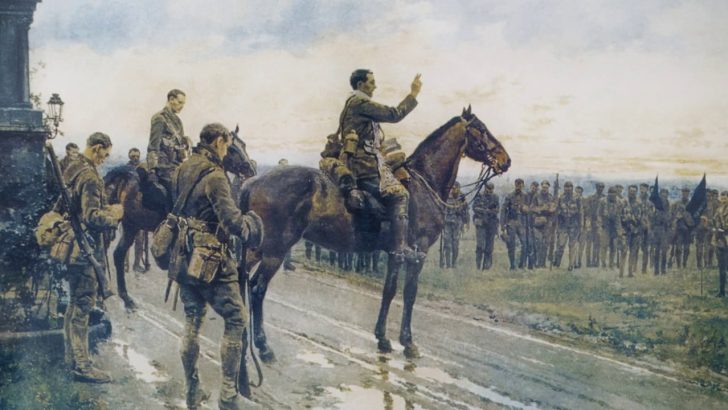Ronan McGreevy
Fr Willie Doyle SJ died as he had lived: fearlessly in the service of others. He ventured into no man’s land to give extreme unction to two officers lying wounded in a shell hole. Another German shell landed among them. Their bodies were never recovered from the battlefield.
Fr Doyle was one of 1,200 men from the 16th (Irish) Division and the 36th (Ulster) Division killed on August 16, 1917. These two divisions, divided by religion and identity yet united against a common enemy, first fought together at Messines Ridge in June 1917.
The attack on Frezenberg Ridge as part of the Battle of Passchendaele was an obscenity even by the debased standards of the First World War. The men from both divisions endured 12 days of shelling before going over the top into a moonscape of mud and a pitiless vista of blasted trees and broken streams. They were slaughtered, a vast expenditure of blood to no end.
Terrible news
Another who died on that terrible day was Lieutenant John Dwyer O’Brien, a Catholic from Cork in a Protestant division. His chaplain imparted the terrible news to his parents. O’Brien had done his duty “nobly for King and country”. He had died a “good soldier and a splendid Catholic”.
Fr Doyle was one of an army of chaplains in an army of Irish Catholics. Death for these men was omnipresent; conditions were terrible.
Most lived day to day in the realisation that each day might be their last. Their faith sustained them.
Fr Doyle spoke of having a pain in his arm administering the sacraments to his men. When they died, it was invariably left to the chaplain to write to his relatives.
The letter would usually state that the soldier had died a painless death, often a white lie, but those written by Catholic chaplains were careful to offer another assurance to grieving families.
“Your brother used to take every opportunity of going to the sacraments,” a priest wrote to the brother of one Irishman who died at the front during Easter Week 1916. “You can be perfectly satisfied that his soul is safe. He was always prepared to die.”
The most famous Irish painting of the First World War is the Last General Absolution of the Munsters at Rue du Bois. It features Fr Francis Gleeson, another stalwart Irish chaplain, blessing the Royal Munster Fusiliers men before the Battle of Aubers Ridge in May 1915.
Neither the author Jessie Louisa Rickard, whose husband was killed at Aubers Ridge, nor the artist Fortunino Matania were there, yet they conjured up something that has more than verisimilitude: they created a work with an enduring emotional resonance strong enough to lodge in our collective imagination.
One sergeant remembered the scene. “There were no ribald jest, or courage buoyed up with alcohol…every man had his Rosary out reciting the prayers in response to Fr Gleeson, just as if at the confraternity at home, instead of having to face death in a thousand hideous forms the following morning.”
Fr Doyle remains one of the most famous Irish casualties of the war. His death is a reminder that the majority of Irishmen who served in the British Army in the First World War were from a Catholic background. This fact confounded the self-image of the two entities that emerged in Ireland after partition.
Some 270,000 Irishmen served. They joined for various reasons. What has been consistently overlooked is how they were encouraged to enlist by many senior clergy in the Catholic Church.
Open letter
In an open letter published two weeks after the outbreak of war, the Bishop of Kildare and Leighlin Patrick Foley exhorted “faithful citizens” to “come to the aid of the armies which are fighting on the side of justice and right”. By one estimate 23 of the 27 Irish Catholic bishops were in favour of the British war effort as was this newspaper.
The extent to which the invasion of neutral Belgium was regarded as a moral outrage at the start of the war cannot be underestimated. Ireland and Belgium had deep ecclesiastical connections stretching back centuries. There had been an Irish College in Louvain since the early 1600s. The burning down of its library in August 1914 caused international outrage and had a particular resonance in Ireland.
Today we associate Catholicism with nationalism, but it is more complicated than that. When Roger Casement tried to recruit an Irish brigade from German prisoner-of-war camps he was told by the senior Irish officers “as well as being Irish Catholics, we have the honour of being British soldiers”.
As Fr Doyle’s life testifies, these men were not less Catholic or Irish for being British soldiers.
Major Willie Redmond MP and the Church of Ireland Rev John Redmond (no relation) were among those who had expressed a hope that the experience of Catholics and Protestants fighting together in a foreign field might bring a better outcome at home. There was no realistic prospect of that happening. Nevertheless, the First World War is part of our shared history, something we have in common. Something else was the esteem Fr Doyle was held in by all who knew him.
One Belfast Presbyterian soldier wrote after his death: “We couldn’t possibly agree with his religious opinions, but we simply worshipped him for other things. He didn’t know the meaning of fear and he didn’t know what bigotry was.”
The Irish Times’ documentary ‘United Ireland: How Nationalists and Unionists Fought Together in Flanders’ will be screened in Veritas House, Lower Abbey Street, Dublin 1, at 1.15pm on Friday, September 1. The trailer can be viewed here: https://www.youtube.com/watch?v=e7u815NpKi4
Ronan McGreevy is the author of Wherever the Firing Line Extends: Ireland and the Western Front published by The History Press.


 Last General Absolution of the Munsters at Rue du Bois.
Last General Absolution of the Munsters at Rue du Bois. 